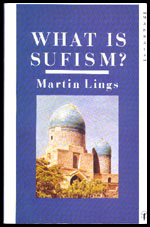|
|
| Volume 7, No 2, Summer 1997 |
![[back]](/anadolu/images/button_back.gif)
|
 Publisher: Unwin Hyman Limited, 15-17 Broadwick Street, London W1V
1FP, ISBN 0-04-297039-3, 139 pages
Publisher: Unwin Hyman Limited, 15-17 Broadwick Street, London W1V
1FP, ISBN 0-04-297039-3, 139 pages
This is another excellent book by Martin Lings (Abu Bakr Siraj ad-Din) the author of "Muhammad", "Ancient Beliefs and Modern Superstitions", "A Sufi Saint of the Twentieth Century" among many others.
Lings defines sufism as: "From time to time a Revelation 'flows' like a great tidal wave from the Ocean of Infinitude to the shores of our finite world; and Sufism is the vocation and the discipline and the science of plunging into the ebb of one of these waves and being drawn back with it to its Eternal and Infinite Source" The book is full of such nice metaphors. He explains the differences between different religions, sufi orders by: "There is only one water, but no two revelations are outwardly the same. Each wave has its own characteristics according to its destination, that is, the particular needs of time and place towards which and in response to which it has providentially been made to flow."
The author is against sufism being separated from Islam: "(those) ... who while claiming to be 'Sufis', maintain that Sufism is independent of any particular religion and that it has always existed, they unwittingly reduce it ... to a network of artificial inland waterways. They fail to notice that by robbing it of its particularity and therefore its originality, they also deprive it of all impetus." Although he agrees that there have been intellectual exchanges between Sufis and Brahmins, and certain notions from Neoplatonism have been adopted by Sufis, he claims that they only touch the surface, and can be regarded within the hadith of "Seek knowledge even if it be in China." He thinks that the Sufi respects the other religions, but with reserve, "until he had actually transcended all forms of spiritual realisation which is very different from a merely theoretic understanding."
Lings gives another view of concentric circles that a Sufi travels as he/she gets better on the road: "Everyone is conscious of 'being at a point' or 'having reached a point', even if this be no more than conciousness of having reached a certain age. Mysticism begins with the conciousness that this point is on a radius. It then proceeds by what might be described as an exploitation of this fact, the radius being a Ray of of Divine Mercy which emanates from the Supreme Centre and leads back to it."
He distinguishes Islam from other religions in mysticism, "All mysticisms are equally universal in the greater sense that they all lead to the One Truth. But one feature of the originality of Islam, and therefore of Sufism, is what might be called a secondary universality, which is to be explained above all by the fact that as the last Revelation of this cycle of time it is necessarily something of a summing up. The Islamic credo is expressed by the Quran as belief in God and His Angels and His Books and His Messengers."
The author reminds us one of the reasons for creation by the Hadith Qudsi 'I was a Hidden Treasure and I wished to be known, and so I created the world'. This hadith well connects to the Sufi principle of 'knowing oneself and then knowing God.'
Lings claims that just as Community of Muslims are according to We have made you a middle people (Qur'an II:143), Sufism is a bridge between East and West. That may be an explanation of why so many American or European people accept Islam after being introduced to it through Sufism or by Sufis.
The book gives how the Sufi sees the Book (Qur'an) and the Messenger (Muhammad, peace and blessings upon him), and how the doctrine and method of Sufism is based on the Qur'an and sayings of the Prophet (PBUH). There is also a history of Sufism beginning from the time of the Prophet (PBUH).
"What is Sufism" is certainly a must read if you do not know what exactly Sufism is. It is still a good book to read even if you know about Sufism, because the book is infused with the author's sincerity and a pleasure to read; as with his other works, its language shows Lings' background as a Shakespeare scholar.